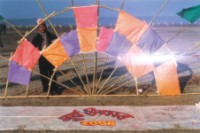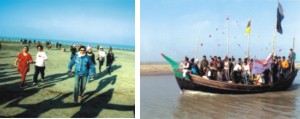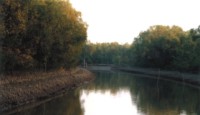 DESTINATION
DESTINATION
“Nijhum Dwip"
Sanjida
Gafur
"Surjo
Utsab" has become a ritual of sorts for Dhakaites. The
English New Year becomes an occasion to celebrate BAA style.
BAA -- Bangladesh Astronomical Association organises a sojourn
every year in areas that the people living in Dhaka and trapped
in day to day routine often crave to venture. The motto of the
association is exploration of nature. The first time a vacation
of this sort was arranged was in St. Martins, the next destination
was Sundarban, then it was time to conquer Keo Karadong, the
highest peak in Bangladesh. At the end of the trail, following
the course, this year, the destination was "Nijhum Dwip".
The name
'Nijhum Dwip' itself contains a romantic connotation about the
place; it gives one a sense of silence and natural splendour
unsullied by human exploration. Which it really is. The island
is situated between Noakhali and Bhola. It is the southern most
island of Bangladesh that lies in the precarious mouth of the
river Padma.
 A
team of 124 explorers, nature enthusiasts to be precise, started
from Sadar Ghat on December 30, 2003. "Moyur 1", an
aeroplane-like launch was the vehicle. We were all set to start
at 3pm, but at last we began our journey at 5:30pm, as crews
of a private channel took time to organise their equipment.
A
team of 124 explorers, nature enthusiasts to be precise, started
from Sadar Ghat on December 30, 2003. "Moyur 1", an
aeroplane-like launch was the vehicle. We were all set to start
at 3pm, but at last we began our journey at 5:30pm, as crews
of a private channel took time to organise their equipment.
Anchor away,
we started to sail to the west on a sinuous river cruise. Paid
to be on board, we were joined with a few media people who were
our guests. The deck was bustling with people. There were people
who were already known to each other and there were many who
got aquatinted to one another for the first time.
The most
horrifying knowledge was that the sarang did not know the route
well. It so happened that in the middle of the night, we were
stuck in a char, and were only happy to find another oil vessel
there. Who in the world does not get pleasure in finding others
in the same predicament that one could not avoid.
 Next
morning, when the tidal wave raised the water, the launch started
to sail again following the trail of the oil vessel that was
heading towards Nijhum Dwip. On 31st December, 3:30pm, we reached
our coveted Dwip. Though we did not have much time to roam about
as night fall was imminent.
Next
morning, when the tidal wave raised the water, the launch started
to sail again following the trail of the oil vessel that was
heading towards Nijhum Dwip. On 31st December, 3:30pm, we reached
our coveted Dwip. Though we did not have much time to roam about
as night fall was imminent.
The launch
had to halt approximately half a kilometre away from Nijhum
Dwip. The water level near the island does lets the big launch
go near the shore. We rented trawlers to get there. In the mean
time, we had finished three meals and had a wonderful experience
in community living. As for using the toilet, you cannot avoid
being used to using the same loo if you plan a nexus with nature.
Enam Al
Haque, M Hamid, Falguni Hamid, Latifa Akand, Kalidas Karmakar,
Alokesh Gosh, were among the heavyweights from disparate fields
who joined us. We had 77 year old Latifa Akand and also a 14
month old child with us. Imagine the combo that we had in the
making.
 We
were divided into small teams consisting of ten members. Then
we went to Nijhum Dwip by trawler. One side of Nijhum Dwip was
brought under aforestation programme which has now developed
into a deep forest. Four pairs of deer were brought in to generate
and the deer population now stands at eight thousand. They are
not the only inhabitants of this beautiful mangrove forest,
but they certainly are a major species. A small human habitat
of 10,000 also exists on the other side of the island.
We
were divided into small teams consisting of ten members. Then
we went to Nijhum Dwip by trawler. One side of Nijhum Dwip was
brought under aforestation programme which has now developed
into a deep forest. Four pairs of deer were brought in to generate
and the deer population now stands at eight thousand. They are
not the only inhabitants of this beautiful mangrove forest,
but they certainly are a major species. A small human habitat
of 10,000 also exists on the other side of the island.
When we
reached the island, only a few courageous teams entered into
the forest to watch deer. The sun was disappearing, the faint
light kept our faint hope alive. The knowledge that there were
no tigers in the forest boosted our courage. We moved deeper.
When the light went dim, we reversed our journey and set off
towards the trawlers. In the mangrove forest land is studded
with spiky roots, so walking becomes an effort. We came out
of the forest, but were not lucky enough to reach the trwalers.
We found ourselves in another side of the island, far away from
our trawlers. We started walking towards them, but we found
one canal, 12 feet or so wide and nearly 6 feet deep. To cross
it was impossible. The sun had already set and stars were blinking
in the sky. To avoid the canal crossing, we had to enter the
forest again in the dark. We were sixteen people with two kids
and four torches to give us light. Fortunately it was a moonlit
night and our predicament turned into an adventure of sorts.
 The
next day was spent preparing different types of things -- torches,
paper sunflowers. The night came, 12 o'clock December 31 and
our troop welcomed 2004 by floating "Mongol Dwip"
in the Bay of Bengal. The dwips (floating lamps) took the shape
of a string and floated away with the waves. Next morning was
the New Year. To welcome the sun, we reached the island. There
the teams installed a large replica of the sun and created an
aisle flanked by paper sunflowers.
The
next day was spent preparing different types of things -- torches,
paper sunflowers. The night came, 12 o'clock December 31 and
our troop welcomed 2004 by floating "Mongol Dwip"
in the Bay of Bengal. The dwips (floating lamps) took the shape
of a string and floated away with the waves. Next morning was
the New Year. To welcome the sun, we reached the island. There
the teams installed a large replica of the sun and created an
aisle flanked by paper sunflowers.
On the first
night of the New Year, there was a big feast with kachchi
biriyani smouldering in the big dekchis. A six member team
of cooks was always busy providing us with fabulous food like
khichuri, vorta, porota, daal. Organiser Benu Bhai
always knew what the stomachs craved for and served us aplenty.
Sky watch
was a programme that gave us the opportunity to fix our gaze
on the universe above through the telescope. There were entertaining
events and activities too -- film shows, cultural programmes,
art competition. All the fun we had, had to end. Time came to
set sail towards home. We reached Dhaka on January 2, 2004,
8:30pm. The trip to Nijhum Dwip is worth taking a second time.

 DESTINATION
DESTINATION A
team of 124 explorers, nature enthusiasts to be precise, started
from Sadar Ghat on December 30, 2003. "Moyur 1", an
aeroplane-like launch was the vehicle. We were all set to start
at 3pm, but at last we began our journey at 5:30pm, as crews
of a private channel took time to organise their equipment.
A
team of 124 explorers, nature enthusiasts to be precise, started
from Sadar Ghat on December 30, 2003. "Moyur 1", an
aeroplane-like launch was the vehicle. We were all set to start
at 3pm, but at last we began our journey at 5:30pm, as crews
of a private channel took time to organise their equipment.
 Next
morning, when the tidal wave raised the water, the launch started
to sail again following the trail of the oil vessel that was
heading towards Nijhum Dwip. On 31st December, 3:30pm, we reached
our coveted Dwip. Though we did not have much time to roam about
as night fall was imminent.
Next
morning, when the tidal wave raised the water, the launch started
to sail again following the trail of the oil vessel that was
heading towards Nijhum Dwip. On 31st December, 3:30pm, we reached
our coveted Dwip. Though we did not have much time to roam about
as night fall was imminent.  We
were divided into small teams consisting of ten members. Then
we went to Nijhum Dwip by trawler. One side of Nijhum Dwip was
brought under aforestation programme which has now developed
into a deep forest. Four pairs of deer were brought in to generate
and the deer population now stands at eight thousand. They are
not the only inhabitants of this beautiful mangrove forest,
but they certainly are a major species. A small human habitat
of 10,000 also exists on the other side of the island.
We
were divided into small teams consisting of ten members. Then
we went to Nijhum Dwip by trawler. One side of Nijhum Dwip was
brought under aforestation programme which has now developed
into a deep forest. Four pairs of deer were brought in to generate
and the deer population now stands at eight thousand. They are
not the only inhabitants of this beautiful mangrove forest,
but they certainly are a major species. A small human habitat
of 10,000 also exists on the other side of the island.  The
next day was spent preparing different types of things -- torches,
paper sunflowers. The night came, 12 o'clock December 31 and
our troop welcomed 2004 by floating "Mongol Dwip"
in the Bay of Bengal. The dwips (floating lamps) took the shape
of a string and floated away with the waves. Next morning was
the New Year. To welcome the sun, we reached the island. There
the teams installed a large replica of the sun and created an
aisle flanked by paper sunflowers.
The
next day was spent preparing different types of things -- torches,
paper sunflowers. The night came, 12 o'clock December 31 and
our troop welcomed 2004 by floating "Mongol Dwip"
in the Bay of Bengal. The dwips (floating lamps) took the shape
of a string and floated away with the waves. Next morning was
the New Year. To welcome the sun, we reached the island. There
the teams installed a large replica of the sun and created an
aisle flanked by paper sunflowers.